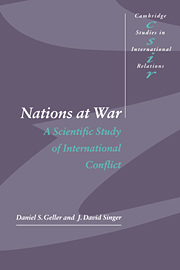Book contents
- Frontmatter
- Contents
- List of figures and tables
- Acknowledgements
- Introduction
- 1 Overview
- 2 Decision models
- 3 War-prone states
- 4 War-prone dyads
- 5 War-prone regions
- 6 War-prone systems
- 7 Case study: Iran/Iraq War (1980)
- 8 Case study: World War I (1914)
- 9 Conclusion
- Appendix 1 List of databases
- Appendix 2 Tables of references by category
- References
- Index
- Cambridge Studies in International Relations
8 - Case study: World War I (1914)
Published online by Cambridge University Press: 16 October 2009
- Frontmatter
- Contents
- List of figures and tables
- Acknowledgements
- Introduction
- 1 Overview
- 2 Decision models
- 3 War-prone states
- 4 War-prone dyads
- 5 War-prone regions
- 6 War-prone systems
- 7 Case study: Iran/Iraq War (1980)
- 8 Case study: World War I (1914)
- 9 Conclusion
- Appendix 1 List of databases
- Appendix 2 Tables of references by category
- References
- Index
- Cambridge Studies in International Relations
Summary
Introduction
The onset and seriousness of World War I (1914) is explained on the basis of empirical uniformities established by systematic quantitative analyses. Scientific explanations of individual events may be provided through inductive subsumption under probabilistic laws, as well as through deductive subsumption under universal laws. This inductive explanation demonstrates that the case of World War I is a specific instance of a set of patterns which have appeared in a much larger number of cases.
World War I conforms to a set of probabilistic laws based on empirical regularities identified at the state, dyadic, and systemic levels of analysis. The states involved in the onset of the war were contiguous or proximate major powers (Austria-Hungary, Russia, Germany, France, and Great Britain); three of these major powers (Germany, Great Britain, and Russia) were moving through critical points in their power cycles; two of these major powers had an unstable capability balance (Germany and Great Britain had recently experienced a power transition); three of these major powers lacked democratic political systems (Austria-Hungary, Germany, and Russia); and the international hierarchy was unstable with a declining leader (Great Britain). Add to this the classification of the Germany/ France dyad as an “enduring rivalry” and the highly polarized alliance systems (Germany/Austria-Hungary and Great Britain/ France /Russia), and the occurrence of a war of enormous magnitude, duration, and severity was a high-probability event consistent with a broad array of empirical war patterns.
- Type
- Chapter
- Information
- Nations at WarA Scientific Study of International Conflict, pp. 156 - 190Publisher: Cambridge University PressPrint publication year: 1998



